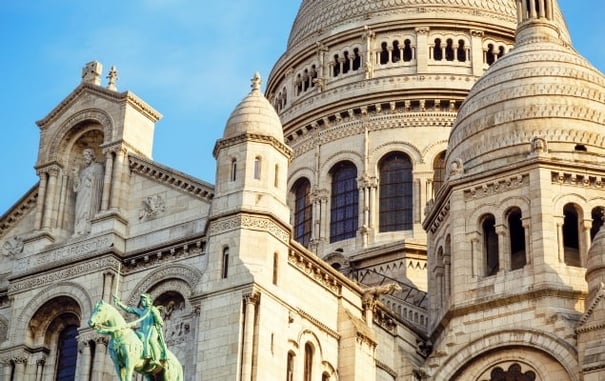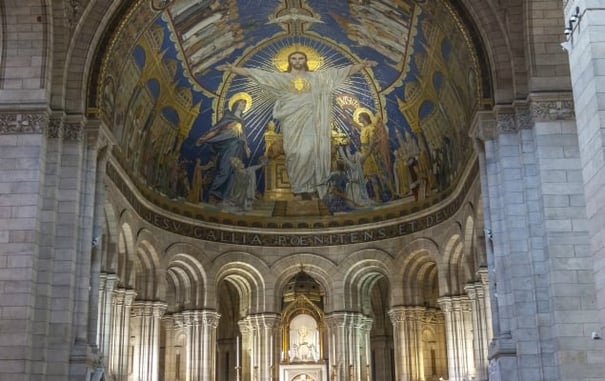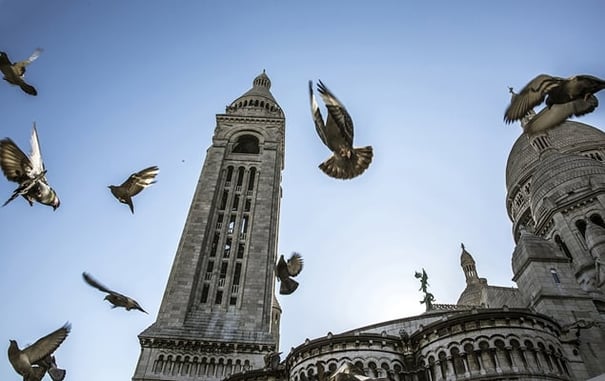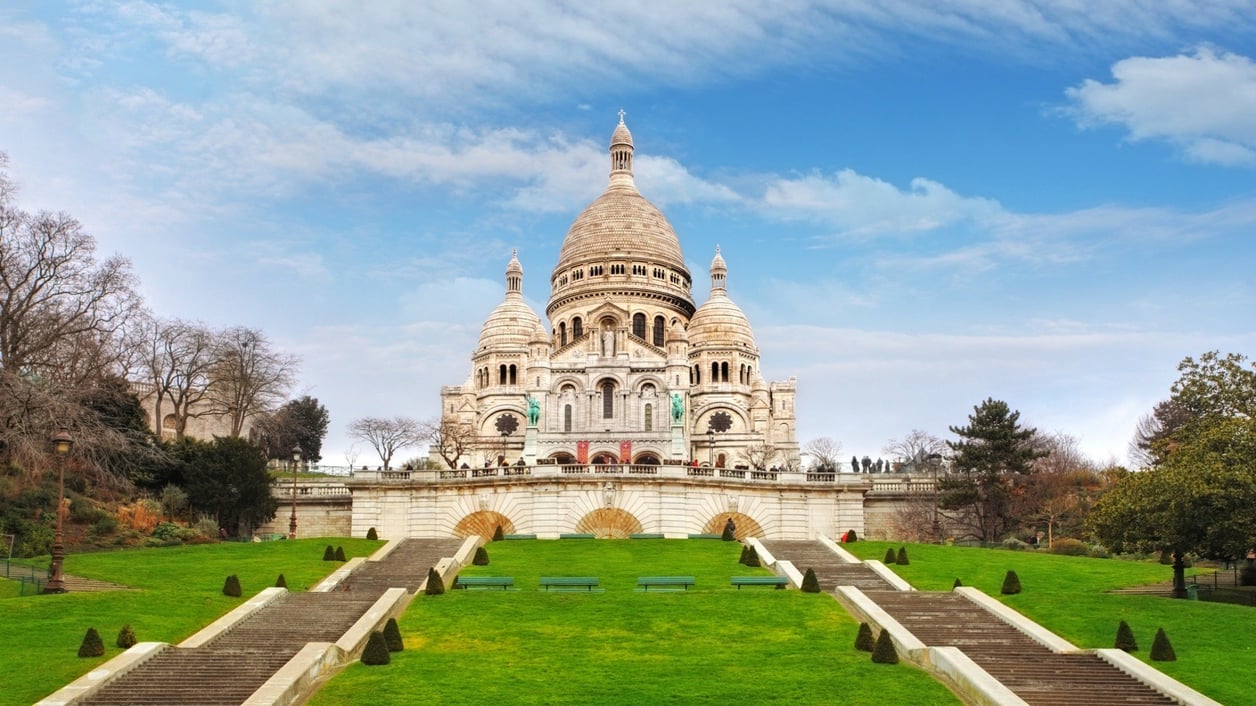Sitting proudly atop Montmartre, the Basilica of Sacré-Cœur occupies the highest point in Paris and is a distinctive figure in the city’s skyline. Consecrated in 1919, the basilica’s Byzantine-inspired features and bleached white travertine facade set it apart from other monuments and historic buildings in the City of Light. The origins of Sacré-Cœur are unique and its distinctive exterior. Struggling to recover from decades of internal turmoil and a recent military defeat, the basilica was built to remedy “a century of moral decline” in France, and is as much a symbol of civic pride as it is a place of worship. Today Sacré-Cœur still operates as a Roman Catholic Church dedicated to the Sacred Heart of Jesus, but also welcomes tourists who come to admire the basilica’s beautiful architectural details, stunning artwork and spectacular views of Paris.

Visiting
Sacré-Cœur is the crown jewel of Montmartre, a neighborhood in the north of Paris known for its cobbled streets and village-like charm. It was in Montmartre that the Impressionist art movement first began to take shape. Renoir, Matisse, van Gogh and other notable impressionists all once made their home here, and many of them would have been witness to the construction of Sacré-Cœur. The multi-domed church is accessible on foot, though it is a bit of a climb to get to the top! If you prefer, you can avoid the uphill walk and take the Funiculaire de Montmarte for direct access to the basilica.
As you approach this impressive example of Romanesque-Byzantine architecture, you’ll spot two bronze statues perched on the tripled-arched entryway. In keeping with the basilica’s nationalist theme, one figure is Joan of Arc and the other is King St. Louis IX. Both storied figures of French history are depicted riding a horse with a sword in-hand. Inside, the muted gray interior of the basilica stands in stark contrast to its gleaming white exterior. The star attraction of Sacré-Coeur’s main interior space is its apse mosaic. Completed in 1923, the 475 square meter (5,112 square feet) mosaic glows in stunning hues of gold and blue. At the center of the mosaic is a depiction of risen Christ with a golden heart.
The Dome
Situated 271 feet above the city, the dome is the highest observation point in the city behind the Eiffel Tower and the views – especially at dusk – are nothing short of spectacular. Access to the dome is located outside the main entrance to the basilica, and there is a separate entrance fee. It is a 300-step climb to the top and there is no elevator service available, but most visitors agree that the views are more than worth it!
The Crypt
The crypt of Sacré-Cœur holds a number of interesting artifacts and treasures. One of the most notable items in its collection is a large statue of St. Denis, the patron saint of Paris, holding his head in his hands. You can also see the foundation stone of the basilica here, along with the tombs of several Cardinals and treasury containing gold clothes, and other items offered to the basilica.

History
Nearly a century after the French Revolution, France was struggling. Clashing ideologies threatened to pull the nation apart from the inside, while foreign troops threatened France from the outside. In the wake of the nation’s loss to the Prussians in the Franco-Prussian War of 1870, the idea for a new basilica to help get France back on the right track was born.
The placement of Sacré-Cœur Basilica in Montmartre was no accident. Translated into English, Montmartre means Mountain of the Martyr. The origins of this macabre neighborhood name date back to the 3rd century. As the story goes, Saint Denis, the patron of Paris, was beheaded on the site where Sacré-Cœur now stands. Following his beheading, Denis proceeded to carry his head in his hands and walk for several miles while preaching all along the way. This legend provided a fitting backdrop for a new basilica
Following a design competition with nearly 80 entrants, a Romanesque-Byzantine design from architect Paul Abadie was chosen. Abadie was himself the son of an architect and had previously worked on the first restoration of Notre Dame Cathedral in the mid-19th century. Construction of the basilica began in 1875, but it wasn’t until 1914 that Sacré-Cœur was completed. Its consecration was scheduled for the same year, but was delayed by the start of World War I. It wasn’t until 1919, nearly 45 years after its foundation stone was laid, that Sacré-Cœur was officially consecrated.
.jpg)
Paris Perfect's Personal Tip
Get the most out of your time in Paris with a guided walking tour of Montmartre! The tour takes you to all the highlights of the City of Light’s most beloved bohemian neighborhood. Lasting two hours, you’ll see Sacré-Cœur Basilica, the famous Moulin Rouge Cabaret, the hauntingly beautiful Montmartre Cemetery and much more!

Essential Information
- Address: 35 Rue du Chevalier de la Barre, 75018 Paris, France
- Closest Metro: Anvers (from Anvers you can walk up to the basilica or take the Funiculaire de Montmarte directly to the entrance of the basilica)
- Website: http://www.sacre-coeur-montmartre.com/english/
- Opening Hours: The basilica is open daily from 6.00 a.m. to 10.30 p.m. The dome is open daily from 8.30 a.m. to 8 p.m. (May to September) and 9 a.m. to 5 p.m. (October to April)
Sign up for our Vacation Perfect newsletter.
